Two more have left us. Jack Tully died on March 7, 2008. Phil Rountree died on March 30. Both were very valuable members of the Florida State University football team of 1947, the team that restarted football at the school. There are but a few of those guys still around, estimated to be about twenty.
The story of how the FSU football program was restarted in 1947 will be told and retold for as long as there is football being played at FSU. It is a story about some members of the "greatest generation" of Americans as Tom Brokaw has dubbed the people that came along just at the right time to win World War II for us and thereby preserve our many freedoms.
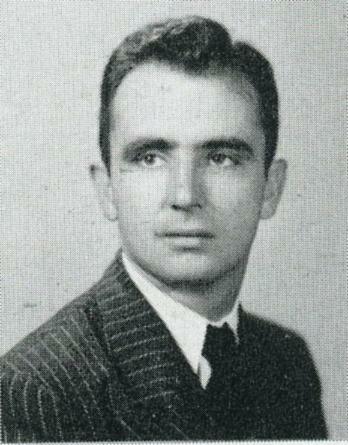 |
Phil Rountree |
Philip Rountree was born in 1923 and raised in Chipley. His father was a lawyer, his mother a teacher. William Jackson Tully was born in Tallahassee in 1926. His ancestors had in the 1850's helped settle an area nearby that is now part of Wakulla County. They had come to Florida in the period of time following the Seminole Indian Wars and just before the Civil War.
When Rountree was six years old and Tully was but three, the stock market came crashing down and banks began to close. America was plunged into the great depression. Like the others of their generation, the two grew up during hard times in America. As children, they enjoyed very few luxuries. Brokaw has described it as a time when "economic despair hovered over the land like a plague."
Things got better. In high school, Rountree played football and basketball and was president of the Chipley High School Student Council. He graduated from Chipley High in the spring of 1941 and entered the University of Florida in the fall of 1941. Tully, in Tallahassee had made his way to Leon High School where he played football and baseball. Times were pretty good but that would change.
On Sunday, December 7, 1941, Rountree was in the midst of his Freshman year at the U of F. Tully was in the tenth grade at Leon High. Rountree, in Gainesville, went to a movie. Afterwards, he ran into a friend who told him that the United States had just been attacked at Pearl Harbor by the Japanese. Rountree did not realize at the time how much the war would affect the two of them, himself and the friend. As it turned out in the days that followed both Rountree and that friend, who was a football player at the University of Florida would serve in the military. Rountree would be fortunate to survive the war years unscathed but the friend was not so lucky as he was severely injured in combat.
Following the attack at Pearl Harbor and the United States' entry into World War II, all of America was affected. Two semesters after the attack, Rountree dropped out of college, married his high school sweetheart, Connie, and enlisted in the United States Army. Tully was too young to enlist, so he stayed in high school another two years and played football and baseball. A high school classmate of his, Mallory Horne (who would later become a lawyer, speaker of Florida's House and President of the State Senate) has described the young Tully as being a "quiet, tough competitor who loved to fight." Immediately following the 1943 football season, seventeen year old Tully talked his mother into signing permission for him and joined the United States Navy. Soon he was being trained to navigate amphibious landing craft. He would serve in the seas of Africa, Italy, France, and South Pacific under combat conditions. Meanwhile Rountree had gone through the officers' program and became an Army Lieutenant who helped train recruits at Camp Blanding in Florida and elsewhere. Eventually, Rountree was assigned to a battle unit and sent overseas. Rountree was on a troop ship in the Pacific when word was received that Atomic bombs had been dropped on Japan. Tully was among the military that went ashore at Nagasaki and examined the devastation done by one of those bombs.
When the war ended, thousands of former soldiers, sailors and marines, funded by government financial assistance, popularly referred to as the "GI Bill" were anxious to further their educations. The existing capacities of the educational institutions were not sufficient to accommodate all of them. Expansion had to take place.
In Tallahassee, then a small town, there existed the Florida State College for Women, a college boasting an outstanding reputation in the study of arts and sciences and having about 2,500 bright young women. The college opened its doors to the returning GI's. In 1946 about 600 privileged young men were allowed into FSCW as students and registered in something called the "Tallahassee Branch of the University of Florida", or "TBUF" as it became known.
Tully left the Navy with the thought of playing football at the University of Miami. However, when he learned that FSCW, in his hometown, was going to admit male students and that the GI bill would pay for it, his plans turned in that direction. Soon he was one of the fortunate "TBUFfers," as they became known, who attended classes alongside those 2,500 young ladies enrolled at FSCW.
Similarly, Rountree had left the military and wished to continue his college education. He came across a newspaper article that told about the establishment of TBUF so instead of going back to Gainesville, he headed for Tallahassee as it was located closer to his hometown of Chipley. He got to Tallahassee in the summer of 1946 and got a job helping prepare the former Dale Mabry Air Base grounds for its new inhabitants, the 600 men who would be attending classes at FSCW as well as the spouses and children of the married ones. Rountree's wife Connie joined him shortly afterwards.
In the Spring of 1947 the Florida legislature met and chose to make another change regarding the college on the hill in Tallahassee. FSCW was renamed, "Florida State University" and officially became a coeducational institution.
Back in the early 1900's when Florida State had previously been a coeducational college, it had participated in intercollegiate football. The 1904 team had an outstanding season and even won the state championship. Therefore, in 1947, it was natural that Florida State would entertain the idea of again fielding an intercollegiate football team. It did not take the school's administration long under the leadership of President Doak Campbell to concur in the idea, and almost overnight the project of playing intercollegiate football was underway at Florida State.
The first coaches
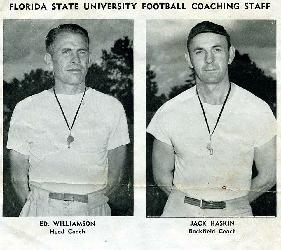 |
Ed Williamson and Jack Haskin |
Ed Williamson, who had grown up in Tallahassee and later played football at the University of Florida had been brought to Florida State to teach physical education and oversee the intramural sports program. He agreed to coach the football team. He was assigned an assistant coach to help in the project, Jack Haskin. Haskin, also a physical education instructor would later become the founder of the FSU Flying High student circus and receive a great deal of acclaim in that endeavor.
The announcement was made that there would be a team. A supply of football shoes was acquired. There were not enough to go around. For awhile, the players worked out on their own. Then, in September of 1947, the team met as a group for the first time. There were about 65 potential players at the meeting in the gymnasium that had served the former air base. Most of the players were military veterans like Tully and Rountree, but a few were just out of high school. Coach Williamson welcomed the men and introduced Coach Haskin. The two coaches outlined plans for the schedule of practices. Williamson would coach linemen while Haskin would work with the backs. Practices would be at "west campus," as the former air field grounds were now known. The practices followed. There were lots of "grass drills" and side-straddle hops. Much time was spent in "catching punts and tackling." The practice uniforms consisted of canvas pants, heavy cotton jerseys and coarse jock straps. In rainy weather, the uniforms never seemed to dry.
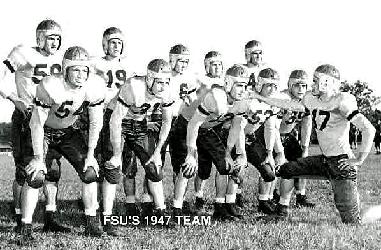 |
Jack Tully is second from
the left on the front row |
Anxiety grew in anticipation of the first game. Players were matched up with the positions that needed to be filled. While the players were required to play both, offense and defense, an early decision was made to have two backfields, one more suited to running the football and another with a little more skill at passing. On campus, guys and girls were lining up dates for the first game. FSCW had an all women cheerleading squad. A new FSU cheerleading squad was organized and boasted three males. In downtown Tallahassee merchants decorated their store windows with posters and displays proclaiming the oncoming game. On October 11, an "East-West scrimmage" was held at night under lights and about 3,000 fans showed up to watch it. Soon thereafter, game uniforms were distributed. There were not enough so some players did not dress for the first game.
The First Game
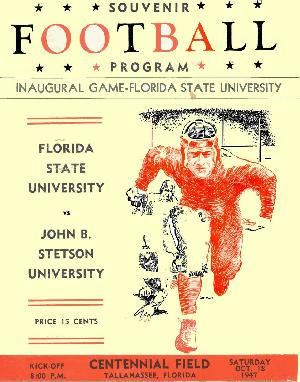 |
FSU-Stetson Game Program |
It was quite symbolic that Stetson University of Deland was the opponent for the first game for the new Florida State team as the same college had supplied the competition in the last game played in 1904 just before Florida State was converted into an all female college. Tallahassee's Centennial Field was the site of the October 18, 1947, first game. The facility had been built originally to house a professional minor league baseball team. It also doubled as a football stadium. The layout for football had the gridiron stretched out over the area that served as left and center fields when the place was used for baseball. Train tracks ran along the hill just beyond the right field fence. Occasionally, during the game, a train came chugging and smoking by. There was a special cheer when that happened. Fans sat in portable bleachers along both sides of the football field. For football, normally there was seating for about 6,000 spectators. For FSU's first game in 1947 there were nearly 8,000 packed into the facility. As a thirteen year old, I was awed by it all.
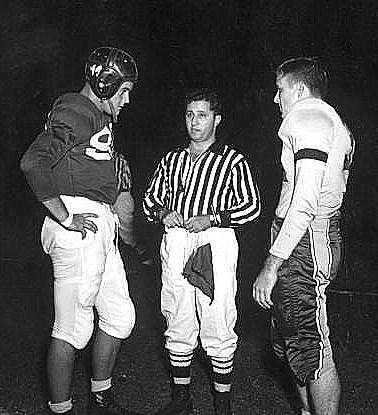 |
First Coin Toss |
Jack Tully had been selected as game Captain for FSU. Wearing number 31 on his gold jersey, he won the coin toss and chose to receive. Stetson kicked off to Florida State. Don Grant, took the opening kickoff on the FSU three yard line and advanced the ball 29 yards to the 32. FSU ran from the Split T formation. Rountree made a place for himself in FSU football history by completing the first forward pass of that first game. From his halfback position and moving toward the end, he took a pitchout and threw the ball about eight yards downfield to fullback Ken MacLean. In the second quarter, Grant threw to Charles McMillan in the southeast corner of the end zone to score the school's first touchdown in the modern era. Tallahassee Democrat sports editor Fred Pettijohn later described it as a "miracle catch" of a "high forward pass." Although FSU scored first, they lost the game to Stetson, 14-6.
A name is adopted
Between the first and second game, the team got a name. The name selected was "Seminoles." At the time, few outside the States of Florida and Oklahoma knew about those brave people who had resisted the federal army's efforts to remove them from Florida. There are conflicting stories about how the name was selected but nearly all accounts indicate that a vote was taken by the student body. There were other names to choose from on the ballot. Different stories mention some of them: "Golden Falcons," "Statesmen," "Crackers," "Senators," "Indians," "Rebels," "Tarpons," "Fighting Warriors." There is even a story circulating that the name "Tallywhackers" was suggested by someone but the administration would not allow its consideration.
The second game - tough weather
FSU's second game took place about a month later on November 14, against Cumberland College in Lebanon, Tennessee. Thirty-three players made the traveling squad that left Tallahassee by bus two days before the game. The bus took two days to get there as the team spent the first night in Griffin, Georgia. There are stories that the team had to sleep on surplus army cots at Cumberland and that their locker room for the game was really a boiler room. The Cumberland game is also quite memorable because of the bad weather. It had rained all day and continued to rain during the game. According to Rountree, "there were no more than twenty spectators there," because of the weather. The ball was quite slippery and both teams kept fumbling. Unfortunately, for FSU, Cumberland scored on a short pass in the second quarter that the receiver managed to hold on to and beat FSU 6-0 as there was no scoring thereafter. A great story that comes from that game is that during the game, some of the FSU players had conversations with the Cumberland center, Ted "Satchmo" Martin who was from Gadsden, Alabama. They told him about FSU and the ladies there. After the game, Martin showed up at the FSU bus ready to go to Tallahassee with the team but was told that there was no room. He did manage to get to FSU later and became an FSU player for the next two years.
The third game was in Tallahassee, against Tennessee Polytechnical Institute. Tennessee Tech was highly favored to win the game. It had rained before the game, so the field was very muddy but it was nothing like the previous game at Cumberland as the rain stopped before game time. FSU fought hard but Tennessee Tech was too much for them and beat the Seminoles 27-6. Bill Osteen scored Florida State's only touchdown from two yards out.
FSU played its fourth game on Thanksgiving afternoon at Centennial Field against Troy State from nearby Troy, Alabama. Troy overpowered FSU in the first half and led at the midway point, 24-0. The Seminoles played much better in the second half but lost the game 36-6. Right Halfback Leonard Melton scored FSU's only touchdown on a one yard run. The touchdown had been set up by an interception by Jack McMillan and a Ken MacLean pass to Chris Banakas.
The fifth and final game for FSU that season was against Jacksonville State of Alabama. Jacksonville State had an 8-0 undefeated record coming into the game and was probably the best team on the FSU first year schedule. In the beginning, there were no surprises. FSU fumbled early on its own 31 and shortly thereafter, with only three minutes off the clock, Jacksonville State scored a touchdown, made the extra point and went ahead 7-0. But from that point on, the game was played evenly and there was no more scoring by either team.
On January 20, 1948, at the Tallahassee Country Club (now known as Capital City Country Club), the Tallahassee Kiwanis Club sponsored the "First Annual Florida State University Football Banquet." It was a great evening. There was barbecue beef and pork along with all of the fixings that culminated with a dessert of cherry pie a la mode. One of the speakers was none other than the governor of Florida, Millard Caldwell. According to The Tallahassee Democrat, the governor told the crowd that "the best football that I saw played last season was by Florida State University." There were other dignitaries as well. Also among the guests were three members of the 1902-04 Florida State teams. Thirty-six players were awarded garnet sweaters with gold letters. You would never know that the team had gone winless by the spirit present at that banquet. FSU's football future was bright.
Successful People
Tully, Rountree and most of the players from that first team went on to very successful lives following that 1947 season. Some, including Tully played more football for FSU. When they left FSU they entered businesses and professions and raised families. Tully went into business and later worked in state government. Rountree became an outstanding educator as a coach, teacher, supervisor, and public official. Most continued as valuable members of their country as they had been in their youth. Some like Tully remained in Tallahassee. Others, like Rountree came back regularly to support their university in various ways. For many years they would get together annually as a group in Tallahassee at The Silver Slipper for a night of food and fun preceding one of FSU's games. "The Slipper" was operated by one of their own, a member of that 1947 team, Chris Kalfas. There are not enough of them to do that anymore.
A great start
There were no last year's starters and no lettermen on that first FSU team. Neither of the two coaches had any previous experience coaching college football. There were no athletic scholarships. No special benefits. From that humble beginning has emerged one of the great programs of modern day football. Forty-six years later the FSU Seminoles advanced from that loss against Stetson in Centennial Field on that night in October of 1947 to a win over Nebraska in the Orange Bowl and the attainment of a National Championship. There has been another national championship won since, and very likely there will be more in the future. There have been lots of conference championships. That wonderful "underdog spirit", that the 1947 team had, has to this day continued to be an integral part of FSU football.
It has been a glorious trip that began with a team made up mostly of World War II veterans, members of the "greatest generation." As FSU football fans, we owe them a lot.
As Americans, we owe them and their generation much more.